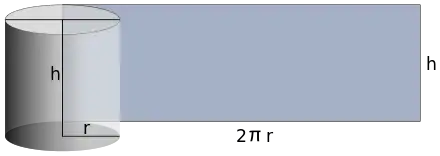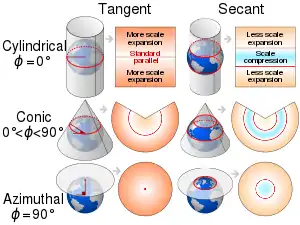
In mathematics, a developable surface (or torse: archaic) is a smooth surface with zero Gaussian curvature. That is, it is a surface that can be flattened onto a plane without distortion (i.e. it can be bent without stretching or compression). Conversely, it is a surface which can be made by transforming a plane (i.e. "folding", "bending", "rolling", "cutting" and/or "gluing"). In three dimensions all developable surfaces are ruled surfaces (but not vice versa). There are developable surfaces in four-dimensional space which are not ruled.[1]
The envelope of a single parameter family of planes is called a developable surface.
Particulars
The developable surfaces which can be realized in three-dimensional space include:
- Cylinders and, more generally, the "generalized" cylinder; its cross-section may be any smooth curve
- Cones and, more generally, conical surfaces; away from the apex
- The oloid and the sphericon are members of a special family of solids that develop their entire surface when rolling down a flat plane.
- Planes (trivially); which may be viewed as a cylinder whose cross-section is a line
- Tangent developable surfaces; which are constructed by extending the tangent lines of a spatial curve.
- The torus has a metric under which it is developable, which can be embedded into three-dimensional space by the Nash embedding theorem[2] and has a simple representation in four dimensions as the Cartesian product of two circles: see Clifford torus.
Formally, in mathematics, a developable surface is a surface with zero Gaussian curvature. One consequence of this is that all "developable" surfaces embedded in 3D-space are ruled surfaces (though hyperboloids are examples of ruled surfaces which are not developable). Because of this, many developable surfaces can be visualised as the surface formed by moving a straight line in space. For example, a cone is formed by keeping one end-point of a line fixed whilst moving the other end-point in a circle.
Application

Developable surfaces have several practical applications.
Developable Mechanisms are mechanisms that conform to a developable surface and can exhibit motion (deploy) off the surface.[3][4]
Many cartographic projections involve projecting the Earth to a developable surface and then "unrolling" the surface into a region on the plane.
Since developable surfaces may be constructed by bending a flat sheet, they are also important in manufacturing objects from sheet metal, cardboard, and plywood. An industry which uses developed surfaces extensively is shipbuilding.[5]
Non-developable surface
Most smooth surfaces (and most surfaces in general) are not developable surfaces. Non-developable surfaces are variously referred to as having "double curvature", "doubly curved", "compound curvature", "non-zero Gaussian curvature", etc.
Some of the most often-used non-developable surfaces are:
- Spheres are not developable surfaces under any metric as they cannot be unrolled onto a plane.
- The helicoid is a ruled surface – but unlike the ruled surfaces mentioned above, it is not a developable surface.
- The hyperbolic paraboloid and the hyperboloid are slightly different doubly ruled surfaces – but unlike the ruled surfaces mentioned above, neither one is a developable surface.
Applications of non-developable surfaces
Many gridshells and tensile structures and similar constructions gain strength by using (any) doubly curved form.
See also
References
- ↑ Hilbert, David; Cohn-Vossen, Stephan (1952), Geometry and the Imagination (2nd ed.), New York: Chelsea, pp. 341–342, ISBN 978-0-8284-1087-8
- ↑ Borrelli, V.; Jabrane, S.; Lazarus, F.; Thibert, B. (April 2012), "Flat tori in three-dimensional space and convex integration", Proceedings of the National Academy of Sciences, 109 (19): 7218–7223, doi:10.1073/pnas.1118478109, PMC 3358891, PMID 22523238.
- ↑ "Developable Mechanisms | About Developable Mechanisms". compliantmechanisms. Retrieved 2019-02-14.
- ↑ Howell, Larry L.; Lang, Robert J.; Magleby, Spencer P.; Zimmerman, Trent K.; Nelson, Todd G. (2019-02-13). "Developable mechanisms on developable surfaces". Science Robotics. 4 (27): eaau5171. doi:10.1126/scirobotics.aau5171. ISSN 2470-9476. PMID 33137737.
- ↑ Nolan, T. J. (1970), Computer-Aided Design of Developable Hull Surfaces, Ann Arbor: University Microfilms International